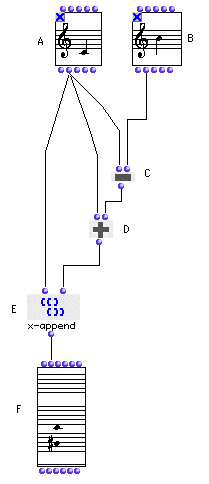OpenMusic Tutorials
Prev| Chapter 1. Using Musical Objects I| Next
Tutorial 2: Inverting an interval
Topics
Changing the direction of an interval using arithmetic functions.
Key Modules Used
The Concept:
We’ll take two pitches from two different Note objects. We’ll
add their difference to the first one, reversing the direction of the
interval, and combine them into a list with x-append. The
results will form a Chord.
The Patch:

First, open the two Note box editors, and change the note, if you want. You can do this either by dragging the note with the mouse, or by clicking on it with the mouse so it is selected and using the cursor keys. Holding shift while using the cursor keys moves the object by octaves. Deleting notes is done by selecting them and hitting delete. Whatever notes you choose, don’t forget to make sure the boxes are locked (with the b key) before continuing. Here are the notes by default:

With these values,
Note (A) outputs 6000 as its midic. Note
(B) outputs 7100. The om- function (C) takes the difference
of the two: -1100. This is the number that must be added to the first
Note to reverse the direction of the interval, with
om+ (D).
We need to combine these notes into a Chord object. The
online documentation (see Quick Tour) tells us that the second input on a
Chord object takes a list of midics. So, we combine the
original first Note’s pitch, 6000, and the result of our
calculation, 4900, into a list with the x-append function,
which takes any inputs and combines them into a single list. The resulting
pitch is displayed below.
Prev| Home| Next
—|—|—
Tutorial 1: Transposing pitches| Up| Tutorial 3: Building
a scale